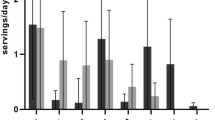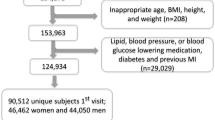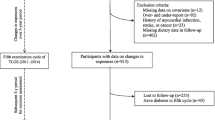Abstract
Purpose
The possible effects of dairy consumption on diabetes prevention remain controversial. The aim of this study was to investigate the association between the dairy consumption and type 2 diabetes (T2D) risk in an elderly Mediterranean population at high cardiovascular risk.
Methods
We prospectively followed 3,454 non-diabetic individuals from the PREDIMED study. Dairy consumption was assessed at baseline and yearly using food frequency questionnaires and categorized into total, low-fat, whole-fat, and subgroups: milk, yogurt, cheeses, fermented dairy, concentrated full fat, and processed dairy. Hazard ratios (HRs) were calculated using Cox proportional hazards regression models.
Results
During a median follow-up of 4.1 years, we documented 270 incident T2D cases. After multivariate adjustment, total dairy product consumption was inversely associated with T2D risk [0.68 (95 % CI 0.47–0.98); P-trend = .040]. This association appeared to be mainly attributed to low-fat dairy; the multivariate HRs (95 % CIs) comparing the highest versus the lowest tertile consumption were 0.65 (0.45–0.94) for low-fat dairy products and 0.67 (0.46–0.95) for low-fat milk (both P-trend <.05). Total yogurt consumption was associated with a lower T2D risk [HR 0.60 (0.42–0.86); P-trend = .002]. An increased consumption of total low-fat dairy and total yogurt during the follow-up was inversely associated with T2D; HRs were 0.50 (0.29–0.85), 0.44 (0.26–0.75), and 0.55 (0.33–0.93), respectively. Substituting one serving/day of a combination of biscuits and chocolate and whole grain biscuits and homemade pastries for one serving/day of yogurt was associated with a 40 and 45 % lower risk of T2D, respectively. No significant associations were found for the other dairy subgroups (cheese, concentrated full fat, and processed dairy products).
Conclusions
A healthy dietary pattern incorporating a high consumption of dairy products and particularly yogurt may be protective against T2D in older adults at high cardiovascular risk.
Similar content being viewed by others
References
Danaei G, Finucane MM, Lu Y et al (2011) National, regional, and global trends in fasting plasma glucose and diabetes prevalence since 1980: systematic analysis of health examination surveys and epidemiological studies with 370 country-years and 2.7 million participants. Lancet 378:31–40
Gillies CL, Abrams KR, Lambert PC et al (2007) Pharmacological and lifestyle interventions to prevent or delay type 2 diabetes in people with impaired glucose tolerance: systematic review and meta-analysis. BMJ 334:299
Hu FB, Manson JE, Stampfer MJ et al (2001) Diet, lifestyle, and the risk of type 2 diabetes mellitus in women. N Engl J Med 345:790–797
Risérus U, Willett WC, Hu FB (2009) Dietary fats and prevention of type 2 diabetes. Prog Lipid Res 48:44–51
Martini LA, Catania AS, Ferreira SRG (2010) Role of vitamins and minerals in prevention and management of type 2 diabetes mellitus. Nutr Rev 68:341–354
Rideout TC, Marinangeli CPF, Martin H et al (2013) Consumption of low-fat dairy foods for 6 months improves insulin resistance without adversely affecting lipids or bodyweight in healthy adults: a randomized free-living cross-over study. Nutr J 12:56
Stancliffe RA, Thorpe T, Zemel MB (2011) Dairy attentuates oxidative and inflammatory stress in metabolic syndrome. Am J Clin Nutr 94:422–430
Tong X, Dong J-Y, Wu Z-W et al (2011) Dairy consumption and risk of type 2 diabetes mellitus: a meta-analysis of cohort studies. Eur J Clin Nutr 65:1027–1031
Elwood PC, Pickering JE, Givens DI, Gallacher JE (2010) The consumption of milk and dairy foods and the incidence of vascular disease and diabetes: an overview of the evidence. Lipids 45:925–939
Aune D, Norat T, Romundstad P, Vatten LJ (2013) Dairy products and the risk of type 2 diabetes: a systematic review and dose-response meta-analysis of cohort studies. Am J Clin Nutr 98:1066–1083
Gao D, Ning N, Wang C et al (2013) Dairy products consumption and risk of type 2 diabetes: systematic review and dose-response meta-analysis. PLoS One 8:e73965
Choi HK, Willett WC, Stampfer MJ et al (2005) Dairy consumption and risk of type 2 diabetes mellitus in men: a prospective study. Arch Intern Med 165:997–1003
Liu S, Choi HK, Ford E et al (2006) A prospective study of dairy intake and the risk of type 2 diabetes in women. Diabetes Care 29:1579–1584
Malik VS, Sun Q, van Dam RM et al (2011) Adolescent dairy product consumption and risk of type 2 diabetes in middle-aged women. Am J Clin Nutr 94:854–861
Van Dam RM, Hu FB, Rosenberg L et al (2006) Dietary calcium and magnesium, major food sources, and risk of type 2 diabetes in U.S. black women. Diabetes Care 29:2238–2243
Margolis KL, Wei F, de Boer IH et al (2011) A diet high in low-fat dairy products lowers diabetes risk in postmenopausal women. J Nutr 141:1969–1974
Villegas R, Gao Y-T, Dai Q et al (2009) Dietary calcium and magnesium intakes and the risk of type 2 diabetes: the Shanghai Women’s Health Study. Am J Clin Nutr 89:1059–1067
Elwood PC, Pickering JE, Fehily AM (2007) Milk and dairy consumption, diabetes and the metabolic syndrome: the Caerphilly prospective study. J Epidemiol Community Health 61:695–698
Grantham NM, Magliano DJ, Hodge A et al (2013) The association between dairy food intake and the incidence of diabetes in Australia: the Australian Diabetes Obesity and Lifestyle Study (AusDiab). Public Health Nutr 16:339–345
Montonen J, Järvinen R, Heliövaara M et al (2005) Food consumption and the incidence of type II diabetes mellitus. Eur J Clin Nutr 59:441–448
Vang A, Singh PN, Lee JW et al (2008) Meats, processed meats, obesity, weight gain and occurrence of diabetes among adults: findings from Adventist Health Studies. Ann Nutr Metab 52:96–104
Kirii K, Mizoue T, Iso H et al (2009) Calcium, vitamin D and dairy intake in relation to type 2 diabetes risk in a Japanese cohort. Diabetologia 52:2542–2550
Soedamah-Muthu SS, Masset G, Verberne L et al (2013) Consumption of dairy products and associations with incident diabetes, CHD and mortality in the Whitehall II study. Br J Nutr 109:718–726
Struijk EA, Heraclides A, Witte DR et al (2013) Dairy product intake in relation to glucose regulation indices and risk of type 2 diabetes. Nutr Metab Cardiovasc Dis 23:822–828
Louie JCY, Flood VM, Rangan AM et al (2013) Higher regular fat dairy consumption is associated with lower incidence of metabolic syndrome but not type 2 diabetes. Nutr Metab Cardiovasc Dis 23:816–821
Von Ruesten A, Feller S, Bergmann MM, Boeing H (2013) Diet and risk of chronic diseases: results from the first 8 years of follow-up in the EPIC–Potsdam study. Eur J Clin Nutr 67:412–419
Sluijs I, Forouhi NG, Beulens JWJ et al (2012) The amount and type of dairy product intake and incident type 2 diabetes: results from the EPIC–InterAct Study. Am J Clin Nutr 96:382–390
O’Connor LM, Lentjes MAH, Luben RN et al (2014) Dietary dairy product intake and incident type 2 diabetes: a prospective study using dietary data from a 7-day food diary. Diabetologia 57:909–917
Estruch R, Ros E, Salas-Salvadó J et al (2013) Primary prevention of cardiovascular disease with a Mediterranean diet. N Engl J Med 368:1279–1290
Kalergis M, Yinko SSLL, Nedelcu R (2013) Dairy products and prevention of type 2 diabetes: implications for research and practice. Front Endocrinol (Lausanne) 4:90
Zong G, Sun Q, Yu D et al (2014) Dairy consumption, type 2 diabetes, and changes in cardiometabolic traits: a prospective cohort study of middle-aged and older Chinese in Beijing and Shanghai. Diabetes Care 37:56–63
Kratz M, Baars T, Guyenet S (2013) The relationship between high-fat dairy consumption and obesity, cardiovascular, and metabolic disease. Eur J Nutr 52:1–24
Chen M, Sun Q, Giovannucci E et al (2014) Dairy consumption and risk of type 2 diabetes: 3 cohorts of US adults and an updated meta-analysis. BMC Med 12:215
Wang H, Livingston KA, Fox CS et al (2013) Yogurt consumption is associated with better diet quality and metabolic profile in American men and women. Nutr Res 33:18–26
Astrup A (2014) Yogurt and dairy product consumption to prevent cardiometabolic diseases: epidemiologic and experimental studies. Am J Clin Nutr 99:1235S–1242S
Pittas AG, Lau J, Hu FB, Dawson-Hughes B (2007) The role of vitamin D and calcium in type 2 diabetes. A systematic review and meta-analysis. J Clin Endocrinol Metab 92:2017–2029
Dong J-Y, Xun P, He K, Qin L-Q (2011) Magnesium intake and risk of type 2 diabetes: meta-analysis of prospective cohort studies. Diabetes Care 34:2116–2122
Chatterjee R, Yeh H-C, Edelman D, Brancati F (2011) Potassium and risk of Type 2 diabetes. Expert Rev Endocrinol Metab 6:665–672
Nilsson M, Stenberg M, Frid AH et al (2004) Glycemia and insulinemia in healthy subjects after lactose-equivalent meals of milk and other food proteins: the role of plasma amino acids and incretins. Am J Clin Nutr 80:1246–1253
El-Abbadi NH, Dao MC, Meydani SN (2014) Yogurt: role in healthy and active aging. Am J Clin Nutr 99:1263S–1270S
Zemel MB, Sun X, Sobhani T, Wilson B (2010) Effects of dairy compared with soy on oxidative and inflammatory stress in overweight and obese subjects. Am J Clin Nutr 91:16–22
Acknowledgments
The authors thank the participants for their enthusiastic collaboration, the PREDIMED personnel for excellent assistance, and the personnel of all affiliated primary care centers for their hard work. This study was funded, in part, by the Spanish Ministry of Health (ISCIII), PI1001407, Thematic Network G03/140, RD06/0045, FEDER (Fondo Europeo de Desarrollo Regional), and the Centre Català de la Nutrició de l’Institut d’Estudis Catalans. The Fundación Patrimonio Comunal Olivarero and Hojiblanca SA (Málaga, Spain), California Walnut Commission (Sacramento, CA), Borges SA (Reus, Spain), and Morella Nuts SA (Reus, Spain) donated the olive oil, walnuts, almonds, and hazelnuts, respectively, used in the study. None of the funding sources played a role in the design, collection, analysis or interpretation of the data, or in the decision to submit the manuscript for publication. CIBERobn (Centros de Investigación Biomédica en Red: Obesidad y Nutrición) is an initiative of ISCIII, Madrid, Spain.
Conflict of interest
Dr. Estruch reports serving on the board of and receiving lecture fees from the Research Foundation on Wine and Nutrition (FIVIN); serving on the boards of the Beer and Health Foundation and the European Foundation for Alcohol Research (ERAB); receiving lecture fees from Cerveceros de España and Sanofi-Aventis; and receiving grant support through his institution from Novartis. Dr. Ros reports grants from RTIC G03/140, ISCIII, Spain, grants from CIBERobn, ISCIII, Spain; serving on the board of and receiving grant support through his institution from the California Walnut Commission, Sacramento CA, USA, non-financial support from Patrimonio Comunal Olivarero, Spain, nonfinancial support from La Morella Nuts, Spain, non-financial support from Borges S.A., Spain, during the conduct of the study; serving on the board and receiving personal fees and other from Flora Foundation, Unilever; personal fees, non-financial support and other from La Asturiana S.A., non-financial support from International Nut Council, outside the submitted work. Dr. Serra-Majem reports serving on the boards of the Mediterranean Diet Foundation and the Beer and Health Foundation. Dr. Pintó reports serving on the board of and receiving grant support through his institution from the Residual Risk Reduction Initiative (R3i) Foundation; serving on the board of Omegafort; serving on the board of and receiving payment for the development of educational presentations, as well as grant support through his institution, from Ferrer; receiving consulting fees from Abbott Laboratories; receiving lecture fees, as well as grant support through his institution, from Merck and Roche; receiving lecture fees from Danone and Esteve; receiving payment for the development of educational presentations from Menarini; and receiving grant support through his institution from Sanofi-Aventis, Kowa, Unilever, Boehringer Ingelheim, and Karo Bio. Dr. Salas-Salvadó reports serving on the board of and receiving grant support through his institution from the International Nut and Dried Fruit Council; serving on the scientific board of the Institute Danone, Spain; receiving consulting fees from Danone; and receiving grant support through his institution from Eroski and Nestlé. No other potential conflict of interest relevant to this article was reported.
Author information
Authors and Affiliations
Corresponding author
Electronic supplementary material
Below is the link to the electronic supplementary material.
Rights and permissions
About this article
Cite this article
Díaz-López, A., Bulló, M., Martínez-González, M.A. et al. Dairy product consumption and risk of type 2 diabetes in an elderly Spanish Mediterranean population at high cardiovascular risk. Eur J Nutr 55, 349–360 (2016). https://doi.org/10.1007/s00394-015-0855-8
Received:
Accepted:
Published:
Issue Date:
DOI: https://doi.org/10.1007/s00394-015-0855-8




